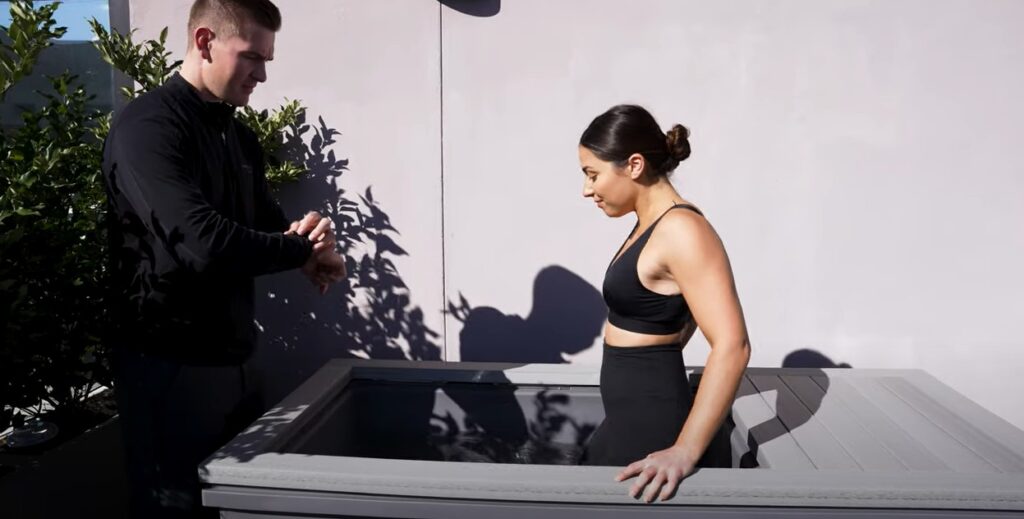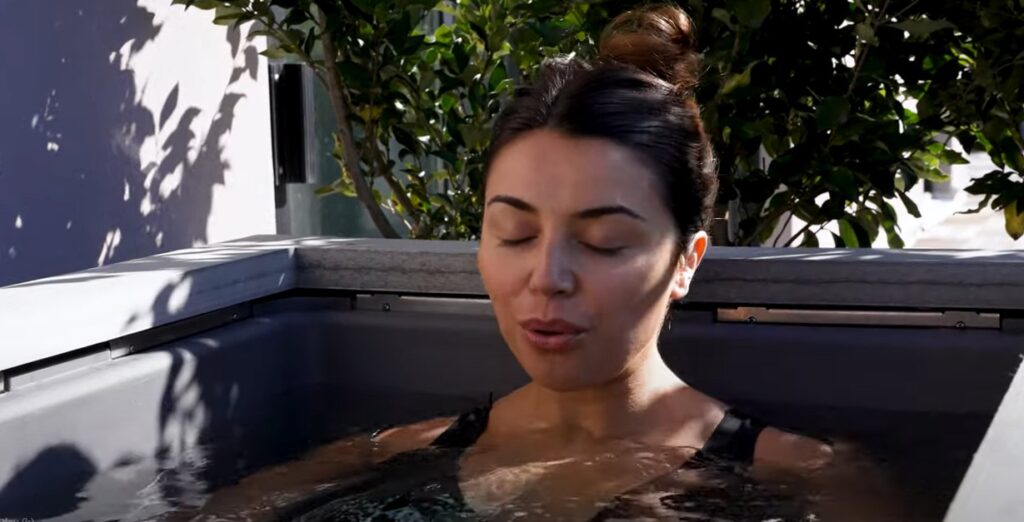Need help?
Unsure whether you need a bath or a plunge, portable or fixed, chiller or iced? Check out Sasha’s cold plunge vs ice bath article to answer all and get clarity on your cold immersion needs.
Imagine waking up and stepping into a tub filled with ice-cold water. It might sound extreme, but that sensation of cold against your skin can do more for your health and well-being than you might expect.
The role of cold plunges in longevity has been gaining popularity as a tool for improving physical health, boosting your mood, and perhaps even extending your life. In this article, you’ll learn why so many people swear by cold plunge and how they could play a pivotal role in longevity.
Contents
- 1 The Science Behind Cold Plunges
- 2 The Benefits of Cold Plunges for Longevity
- 3 Cold Plunges and Mental Health
- 4 Practical Tips for Starting Your Cold Plunge Journey
- 5 Cold Plunges vs. Cryotherapy
- 6 The Impact of Cold Plunging on Hormones
- 7 The Mental Discipline of Cold Plunging
- 8 Cold Plunging as a Social Activity
- 9 Safety Considerations
- 10 Making Cold Plunges a Consistent Practice
The Science Behind Cold Plunges
You might be wondering, why would anyone willingly subject themselves to freezing temperatures? The answer lies in the physiological responses that your body undergoes when exposed to cold. Cold plunges trigger several biological processes that contribute to enhanced health.
When you immerse yourself in cold water, your body reacts immediately by constricting blood vessels, a process known as vasoconstriction. This results in blood being sent to your core to keep your vital organs warm. When you emerge from the cold water, the blood vessels reopen, leading to improved circulation.
Another key benefit is the effect on the autonomic nervous system. Exposure to cold stimulates the parasympathetic nervous system, which is known to help reduce stress and promote relaxation. Your body also releases norepinephrine—a hormone and neurotransmitter linked to increased focus, reduced inflammation, and improved mood.

The Benefits of Cold Plunges for Longevity
Enhanced Cardiovascular Health
One of the core benefits of cold plunging is improved cardiovascular health. Your heart is responsible for pumping blood throughout your body, and a stronger circulatory system helps deliver oxygen and nutrients more efficiently. Repeated exposure to cold water has been linked to a more resilient cardiovascular system, which could reduce your risk of conditions like hypertension and heart disease—two major factors in longevity.
Boosted Immune Function
Regular cold plunges can also give your immune system a boost. Studies have shown that cold-water immersion can increase the production of white blood cells, which help your body fight off illnesses. The idea is that your body adapts to the challenging environment, and this adaptation translates to better immune resilience over time.
Reduced Inflammation and Muscle Recovery
If you exercise regularly, you know that inflammation and muscle soreness can be barriers to consistent workouts. Cold plunges can be a fantastic tool for reducing inflammation and aiding in muscle recovery. The cold causes blood vessels to constrict, reducing swelling and helping your muscles recover faster. This means you can stay active more often, and consistent physical activity is one of the biggest contributors to a longer, healthier life.
Cold Plunges and Mental Health
A Mood Boost Like No Other
You may have heard of the “runner’s high” that comes after a great jog. Cold plunges can create a similar feeling by releasing endorphins—your body’s natural painkillers and mood enhancers. Many people report feeling euphoric after a cold plunge, and it’s no surprise that this boost in mood can be beneficial for long-term mental health.
The practice of facing the cold is also about embracing discomfort. By willingly exposing yourself to cold temperatures, you learn to tolerate discomfort, which can make everyday stresses feel more manageable. This kind of resilience contributes to better mental health, which in turn supports longevity.

Practical Tips for Starting Your Cold Plunge Journey
Start Slow and Build Up
If you’ve never tried a cold plunge before, it’s important to start slowly. Start with a cold shower—even 30 seconds at the end of your regular warm shower can be enough to acclimate your body to the sensation. From there, you can gradually increase the duration of the cold exposure.
For your first actual cold plunge, try aiming for a temperature between 50-59°F (10-15°C) and stay in for just one to two minutes. You can increase the time and lower the temperature as your body becomes more comfortable with the practice.
Equipment to Consider
If you’re serious about the role of cold plunges in longevity and incorporating cold plunges into your routine, there are products that can help make the experience more convenient and enjoyable. You can start with something simple like a bathtub filled with cold water and ice. However, there are also more advanced options available that you can consider investing in.
To get clarity on what the right equipment is for you I’d recommend reading Sasha’s cold plunge vs ice bath article and you can get links to suggestions from the CIL team there.
Breathing Techniques to Manage the Cold
One of the challenges of cold plunging is managing the initial shock of the cold. You can use breathing techniques to help your body adapt and remain calm. Taking deep, controlled breaths and focusing on long exhales can help reduce the fight-or-flight response that occurs when you first get into cold water. Practicing the Wim Hof Method, which involves specific breathing exercises, can also help you mentally and physically prepare for the plunge.
Cold Plunges vs. Cryotherapy
You might also be curious about cryotherapy, which involves exposing your body to extremely cold air for a few minutes. While cryotherapy has its own benefits, cold plunging tends to be more accessible and provides the added advantage of hydrostatic pressure from the water, which further aids in reducing inflammation. Plus, cold plunging at home can be a cost-effective alternative compared to regular visits to a cryotherapy chamber.
The Impact of Cold Plunging on Hormones
Testosterone and Growth Hormone Boost
Hormonal balance plays a huge role in aging and longevity, and cold plunging can have a positive impact here as well. Studies suggest that cold exposure can increase testosterone levels in men, as well as boost growth hormone production. These hormones are critical for maintaining muscle mass, energy, and overall vitality as you age.
Improved Sleep Quality
Cold plunging can also help regulate sleep patterns. When you expose yourself to cold water, your body’s core temperature drops afterward, signaling to your body that it’s time to rest. Many people report falling asleep more easily and experiencing deeper sleep after a cold plunge, which is an essential component of health and longevity.
The Mental Discipline of Cold Plunging
The role of cold plunges in longevity and what makes cold plunging so beneficial is the mental discipline that it fosters. When you commit to cold plunging, you’re making a decision to do something difficult. This mental practice of overcoming discomfort can translate into other areas of your life—helping you develop grit and resilience, qualities that are important for maintaining a healthy and fulfilling life.
You’ll also find that regular cold plunging builds a sense of accomplishment. Each time you immerse yourself in cold water, you’re pushing your limits and reinforcing the belief that you’re capable of doing hard things. This kind of mental fortitude is invaluable, especially as you grow older and face new challenges.
Cold Plunging as a Social Activity
Cold plunging can also be a great way to connect with others. There are communities all around the world that practice cold-water swimming together, particularly in places like Scandinavia, where cold plunging has long been part of the culture. If you’re interested, you can look for local groups or classes that practice cold plunging or cold-water swimming. The social aspect makes the experience more enjoyable and can provide motivation to keep going.
Safety Considerations
It’s important to remember that cold plunging is a stressor, and you need to approach it cautiously. If you have any underlying heart conditions or respiratory issues, you should consult your doctor before beginning a cold plunge routine. Even if you’re in good health, always listen to your body. If you feel dizzy, excessively cold, or experience pain, it’s time to get out of the water.
You should also be mindful of the water temperature and duration. Start slow, especially if you’re new to cold exposure. The goal is to build your tolerance over time without overwhelming your body.
Making Cold Plunges a Consistent Practice
To fully experience the longevity benefits of cold plunging, consistency is key. It doesn’t have to be a daily activity, but even 2-3 times a week can provide substantial benefits. Consider scheduling your cold plunges around your workouts to help with muscle recovery or in the morning to kick-start your day with a boost of energy.
Cold plunging is more than just a health trend—it’s a practice that can transform your physical health, mental well-being, and overall outlook on life. The science shows that the benefits are real, and countless people have experienced the powerful effects firsthand. Whether you decide to invest in an ice barrel, use a simple bathtub, or join a community of cold-water swimmers, the key is to take that first step. Embrace the cold, challenge yourself, and reap the incredible benefits that this age-old practice has to offer for a longer, healthier life.
Now, it’s time to take the plunge—literally. You have everything you need to start incorporating cold plunges into your lifestyle. The path to longevity is all about making consistent, health-focused choices, and this is one invigorating habit that could make a real difference.
This website may contain affiliate links. As an affiliate, we may earn a commission from qualifying purchases at no additional cost to you.

